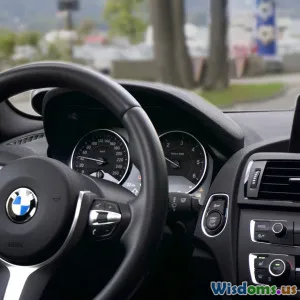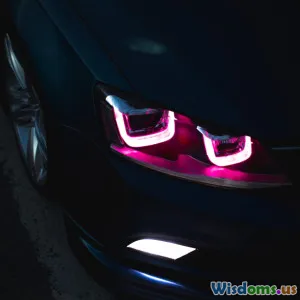
Step by Step Guide To V2X Feature Upgrades
8 min read Detailed guide on upgrading V2X features for smarter, safer connected vehicles with expert insights and practical steps. (0 Reviews)
Step-by-Step Guide to V2X Feature Upgrades
Introduction
Vehicle-to-Everything (V2X) communication represents a transformative leap in automotive technology, enabling vehicles to communicate with other vehicles, infrastructure, and even pedestrians. As automatic and connected vehicles become increasingly common, upgrading V2X features is critical for enhancing road safety, traffic efficiency, and the overall driving experience.
But how do you approach these upgrades methodically? This comprehensive guide demystifies the complexities of V2X feature upgrades by breaking down the technology, key components, challenges, and practical implementation strategies into clear, actionable steps.
Whether you’re a developer, fleet manager, or automotive engineer, understanding how to navigate V2X upgrades can position you at the forefront of intelligent transportation systems.
Understanding V2X Technology
Before delving into the upgrade process, it's important to grasp the basics of V2X:
- Definition: V2X encompasses various communication types like Vehicle-to-Vehicle (V2V), Vehicle-to-Infrastructure (V2I), Vehicle-to-Pedestrian (V2P), and Vehicle-to-Network (V2N).
- Purpose: To enable vehicles and other devices to exchange data in real-time to avoid collisions, optimize traffic flows, and enhance situational awareness.
- Technologies Used: Primarily DSRC (Dedicated Short Range Communications) and C-V2X (Cellular V2X).
Key Components Involved
- Onboard Units (OBUs): Installed in vehicles for communication.
- Roadside Units (RSUs): Infrastructure elements aiding communication.
- Communication Protocols: Standards governing data exchange.
According to the U.S. Department of Transportation, implementing V2X could prevent up to 80% of crashes involving non-impaired drivers, underscoring its life-saving potential.
Step 1: Conduct a Thorough Assessment of Current Systems
Evaluate Existing Hardware and Software
Identify the current V2X capabilities of your vehicles or infrastructure:
- What communication hardware is installed?
- Which protocols (DSRC or C-V2X) are supported?
- Check the firmware and software versions.
For instance, older OBUs might support only DSRC, limiting upgrade paths if you want to integrate 5G-based C-V2X features.
Perform Compatibility Audits
Ensure existing components can be upgraded or if hardware replacements are necessary. Engage with suppliers for detailed specifications to map upgrade feasibility.
Analyze Security Posture
V2X communication involves sensitive data, so assess your current cybersecurity strategies, including encryption methods and intrusion detection capabilities.
Step 2: Define Upgrade Objectives and Requirements
Clearly articulate what your upgrade aims to achieve. Common objectives include:
- Enhanced communication range or speed.
- Integration of new communication standards (e.g., transition from DSRC to C-V2X).
- Improved cybersecurity or privacy measures.
- Additional safety applications (e.g., emergency braking alerts).
Set Measurable Goals
Using SMART (Specific, Measurable, Achievable, Relevant, Time-bound) criteria helps streamline the project's scope and evaluation.
Example: “Upgrade 50 fleet vehicles to support C-V2X communication within 12 months, reducing collision alerts’ latency by 30%."
Step 3: Select Appropriate Technology Standards and Protocols
Evaluate DSRC Versus C-V2X
- DSRC operates in the 5.9 GHz band with fast, low-latency communication but limited range.
- C-V2X leverages 4G/5G cellular technology offering broader coverage and scalability.
Industry trends show a gradual shift to C-V2X due to mobile network integration advantages.
Review Regulatory Compliance
Confirm chosen technologies meet local and international regulatory standards (e.g., ETSI ITS in Europe, FCC rules in the US).
Step 4: Upgrade Hardware Components
Replace or Retrofit OBUs and RSUs
Hardware capability is pivotal. Retrofitting existing units with new communication chips or entirely swapping units may be required.
- Manufacturers like Qualcomm and NXP Semiconductors offer C-V2X compatible modules.
- RSU upgrades improve infrastructure-to-vehicle interactions.
Consider Power and Environmental Specifications
Ensure new hardware can withstand automotive environmental stresses such as temperature variations and vibrations.
Step 5: Update Software and Firmware
Ensure Protocol Stack Updates
Software upgrades should support new standards, security patches, and improved algorithms for communication and data handling.
Utilize Over-the-Air (OTA) Updates
OTA enables remote patching and feature deployment without the need for physical vehicle visits, greatly improving maintainability.
Tesla’s success with OTA firmware updates illustrates efficiency; it significantly reduces downtime and enhances security responsiveness.
Step 6: Implement Robust Security Enhancements
Deploy Encryption and Authentication
Features such as Public Key Infrastructure (PKI) support secure message exchanges, preventing malicious actors from injecting false information.
Introduce Intrusion Detection Systems (IDS)
Active monitoring of communication channels helps detect abnormal behavior in real-time.
Industry experts from the IEEE emphasize that security is the backbone of trust in V2X networks.
Step 7: Integrate and Test Upgraded Features
Laboratory and Field Testing
- Simulate different traffic scenarios to evaluate communication latency, packet loss, and responsiveness.
- Real-world driving tests to verify performance under varying conditions.
Use Key Performance Indicators (KPIs)
Monitor metrics such as message delivery success rate, latency, and system uptime to validate upgrades.
Example: In tests, C-V2X showed up to 40% longer communication range compared to legacy DSRC, enhancing early warning capabilities.
Step 8: Train Staff and End Users
Ensure that fleet managers, drivers, and technicians understand new features:
- Conduct workshops and provide documentation.
- Share insights on interpreting new alerts or system behaviors.
Engaged users promote safer and more effective use of V2X features.
Step 9: Deploy and Monitor Continuously
Implement the upgrades across your fleet or infrastructure gradually while monitoring system health:
- Use analytics to identify anomalies or degradation.
- Schedule periodic updates based on feedback and evolving standards.
Such proactive maintenance ensures system longevity and continuous benefits.
Conclusion
Upgrading V2X features is a multifaceted but rewarding process essential for advancing connected vehicle ecosystems. By following this step-by-step guide—assessing current systems, defining clear goals, choosing the right technologies, and adhering to best practices in security and testing—you can successfully elevate your V2X capabilities.
In an era where intelligent transport systems save lives and streamline mobility, these upgrades not only offer technological advantages but serve as a foundation for a safer, smarter future on the roads.
Embrace the future of driving by taking systematic, informed action on your V2X upgrades today.
Further Reading and Resources
- U.S. Department of Transportation: V2X Fact Sheet
- IEEE Communications Society: V2X Security Standards
- Qualcomm C-V2X Solutions Overview
- SAE International Reports on V2X Communication
Author’s Note: Always coordinate with certified suppliers and comply with local regulations during upgrades to maximize safety and effectiveness.
Rate the Post
User Reviews
Other posts in Connected Vehicles
Popular Posts
















